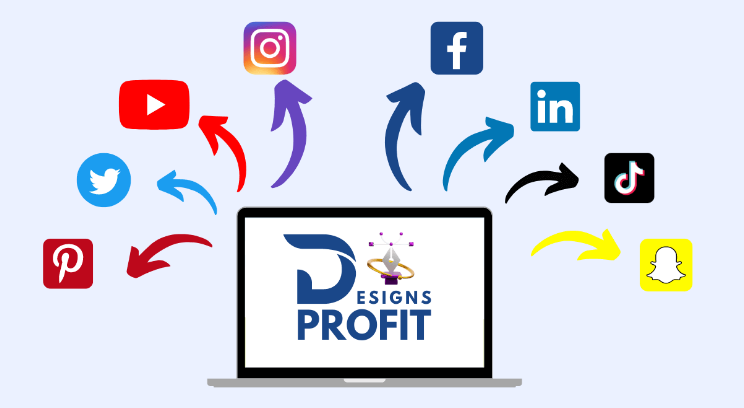Designsprofit is an online marketplace that connects businesses and individuals with professional designers for their design needs. It provides a wide range of design services, including logo design, website design, and graphic design.
With a user-friendly platform and a pool of talented designers, Designsprofit offers affordable and high-quality design solutions to help businesses establish their brand identity and enhance their visual presence in the market. Designsprofit is your one-stop destination for all your design needs.
From logos to websites, and everything in between, Designsprofit connects you with professional designers who can bring your vision to life. With a user-friendly platform and a vast talent pool, Designsprofit offers affordable and high-quality design solutions that cater to businesses of all sizes. Whether you’re a startup looking to establish your brand identity or an established company in need of a design refresh, Designsprofit has got you covered. Say goodbye to the hassle of searching for a designer and let Designsprofit handle all your design projects seamlessly.
Understanding Design Profitability
Designsprofit is a comprehensive guide to understanding design profitability. Discover effective strategies to maximize your profits and optimize your design business for success.
Understanding Design Profitability In today’s competitive business landscape, the importance of design cannot be overstated. Effective design plays a crucial role in attracting customers, building brand recognition, and ultimately, driving profitability. Design Profitability, a term that refers to the ability of design to generate revenue and increase profits, is a key consideration for businesses of all sizes.Importance Of Design In Business
Design is not just about making things look good; it is about creating an experience that resonates with customers and drives them to take action. In fact, studies have shown that businesses that prioritize good design outperform their competitors in terms of revenue and growth. Here’s why design is an essential component of a successful business: 1. Enhances Brand Identity: A well-designed brand creates a strong visual identity that sets a business apart from its competitors. Consistent branding across all platforms and touchpoints increases brand recognition and builds trust with customers. 2. Improves User Experience: Design influences how users navigate and interact with a website or product. User-friendly interfaces and intuitive designs enhance the user experience, leading to increased customer satisfaction and repeat business. 3. Increases Conversion Rates: Effective design elements, such as compelling visuals, persuasive copy, and clear calls-to-action, can significantly impact conversion rates. A well-designed website or marketing material can drive more leads and conversions, ultimately boosting profitability.Factors Affecting Design Profitability
While design plays a pivotal role in business success, several factors can influence its profitability. By understanding these factors, businesses can make informed decisions and optimize their design strategies for maximum profitability. Here are some key factors to consider: 1. Target Audience: Understanding the needs, preferences, and demographics of your target audience is vital for designing profitable solutions. Tailoring your design to resonate with your audience can result in higher engagement and increased profitability. 2. Functionality: Aesthetics alone do not determine the profitability of a design. Functionality is equally important. A design that is visually appealing, intuitive, and easy to use can enhance the overall customer experience, leading to higher profitability. 3. Competition Analysis: Analyzing your competitors’ design strategies can provide valuable insights into industry trends and customer expectations. By staying ahead of the competition and offering unique design solutions, businesses can gain a competitive edge and improve profitability. 4. Brand Consistency: Consistency across all design elements, including color schemes, typography, and imagery, is crucial for establishing a strong brand identity. A consistent brand image builds trust and credibility, leading to increased profitability. 5. Continuous Improvement: Design is an ongoing process that requires constant evaluation and improvement. By analyzing user feedback, tracking key performance indicators, and iterating design elements, businesses can optimize their design for profitability. In conclusion, understanding design profitability is vital for businesses looking to thrive in today’s competitive market. By recognizing the importance of design in driving business success and considering the various factors that affect design profitability, businesses can leverage design as a powerful tool for increasing revenue and profitability.
Credit: medium.com
Creating Profitable Designs
Designsprofit specializes in creating profitable designs that not only captivate audiences but also drive business success. Effective designs are not just visually appealing; they are carefully crafted with a clear understanding of the business goals and the target audience. In this blog post, we will explore three crucial steps for creating profitable designs: defining business goals, target audience analysis, and design research and inspiration.
Defining Business Goals
Before diving into the design process, it’s important to define clear and measurable business goals. These goals serve as the foundation for creating designs that align with the overall objectives of the company. Whether it’s increasing sales, enhancing brand awareness, or driving website traffic, understanding the desired outcomes enables designers to create visuals that effectively communicate the desired message.
Target Audience Analysis
Next, conducting a thorough analysis of the target audience is essential for designing profitable visuals. By researching and understanding the demographics, interests, and preferences of the target audience, designers can tailor their creations to resonate with the intended viewers. This analysis ensures that the designs not only attract attention but also connect on a deeper level, resulting in increased engagement and conversions.
Design Research And Inspiration
Design research and inspiration are crucial steps in the creative process. By immersing themselves in the industry, studying competitors, and staying up-to-date with the latest design trends, designers gain valuable insights and inspiration. This research helps them create designs that stand out from the competition and align with the current market preferences, ensuring the highest potential for profitability.
By following these steps, Designsprofit crafts designs that not only impress visually but also contribute to the overall success of businesses. With a clear understanding of business goals, a deep analysis of the target audience, and a continuous commitment to design research and inspiration, profitable designs become a reality.
Design Principles For Profitability
When it comes to designing a website, there are several key principles to keep in mind. These principles not only contribute to creating an engaging and visually appealing website, but they also play a crucial role in driving profitability. In this blog post, we will explore three essential design principles for profitability: Simplicity and Functionality, Consistency and Branding, and Emotional Appeal.
Simplicity and functionality are two design principles that go hand in hand when it comes to creating a profitable website. A simple and clean design not only enhances the user experience but also makes it easier for visitors to navigate and find what they are looking for. By keeping the design clutter-free and focused on the essentials, you can ensure that users can quickly understand your website’s purpose and take the desired actions.
Functionality is equally important. Every element on your website should serve a purpose and contribute to the overall functionality. From intuitive navigation menus to clear call-to-action buttons, each element should be strategically placed to guide users towards profitable actions, such as making a purchase or filling out a contact form.
Consistency is key when it comes to design, particularly in terms of branding. A consistent design helps establish a strong brand identity and build credibility with visitors. By using consistent colors, fonts, and imagery, you create a cohesive and recognizable brand that leaves a lasting impression.
| Key Elements of Consistency and Branding: |
|
By maintaining consistency in your design and branding, you build trust and familiarity with your audience, increasing the likelihood of repeat visits and conversions.
Emotional appeal is a design principle that taps into the power of human emotions to drive profitability. By evoking emotions such as joy, excitement, or even empathy through your design, you can create a memorable and impactful user experience.
Using compelling visuals, captivating storytelling, and relatable content, you can connect with your audience on an emotional level. When visitors feel a strong emotional connection to your brand, they are more likely to engage with your website, share it with others, and ultimately convert into loyal customers.
In conclusion, these design principles for profitability – simplicity and functionality, consistency and branding, and emotional appeal – are crucial elements to consider when designing a website. By incorporating these principles into your design strategy, you can create a visually appealing, user-friendly, and profitable website that effectively engages your target audience.

Credit: iot.electronicsforu.com
Strategies For Increasing Design Profitability
In today’s highly competitive business landscape, design plays a pivotal role in attracting customers and driving profits. To harness the full potential of design, businesses must implement effective strategies that maximize design profitability. In this article, we will explore three key strategies for increasing design profitability: Identifying Design Trends, Continuous Improvement and Iteration, and Design Testing and Optimization.
Identifying Design Trends
Staying ahead of the curve is crucial in the design world. By closely monitoring and identifying emerging design trends, businesses can ensure that their designs remain fresh, captivating, and appealing to their target audience. When it comes to identifying design trends, businesses can:
- Follow industry-leading design publications and blogs
- Attend design conferences and trade shows
- Study successful competitors’ design strategies
- Tap into customer feedback and preferences
Continuous Improvement And Iteration
In the fast-paced digital era, complacency is detrimental to design profitability. To stay competitive, businesses must adopt a culture of continuous improvement and iteration. This involves:
- Regularly analyzing design performance and metrics
- Critically evaluating customer feedback and suggestions
- Conducting A/B testing to identify design enhancements
- Encouraging design team collaboration and brainstorming
Design Testing And Optimization
To maximize design profitability, businesses need to ensure that their designs are optimized for success. This involves:
- Conducting usability testing to improve user experience
- Implementing responsive design to cater to various devices
- Performing multivariate testing to identify high-performing design variations
- Optimizing loading times and performance for better user engagement
By implementing these strategies, businesses can leverage the power of design to increase their profitability, attract new customers, and retain existing ones. Remember, design is not just aesthetics – it is an integral component of the overall success of a business. Stay vigilant, embrace innovation, and continuously refine your design approach to unlock its true potential.
Collaboration And Communication In Design Profitability
Collaboration and communication play a crucial role in the profitability of design projects. These elements facilitate effective teamwork, ensuring that all stakeholders are on the same page and working towards the same goals. In this article, we will explore key factors to consider when it comes to collaboration and communication in design profitability, including the importance of effective design briefs, cross-functional collaboration, and client communication.
Effective Design Briefs
An effective design brief acts as a roadmap for design projects, providing clear instructions and guidelines for designers. It helps to align the expectations of the clients, designers, and other team members involved. A well-crafted design brief includes essential details such as project objectives, target audience, brand guidelines, and desired deliverables. By providing designers with a comprehensive understanding of the project requirements, an effective design brief minimizes the chances of miscommunication and rework, ultimately saving time and resources.
Cross-functional Collaboration
Cross-functional collaboration involves bringing together individuals from different departments or roles to work towards a common design goal. By encouraging collaboration between designers, developers, marketers, and other stakeholders, organizations can leverage diverse perspectives and skill sets to create innovative and cohesive design solutions. This collaborative approach promotes synergy, enhances problem-solving capabilities, and fosters a sense of ownership among team members. Whether it’s brainstorming sessions, regular meetings, or project management tools, effective cross-functional collaboration enables streamlined workflows and optimized design outcomes.
Client Communication
Client communication is vital throughout the design process. Regular and clear communication builds trust, keeps clients informed about the progress, and ensures that their requirements are met. It is essential to establish a communication plan right from the start of the project, including preferred communication channels, meeting schedules, and reporting mechanisms. Regular check-ins, progress updates, and milestone reviews are essential to keep clients engaged and make them feel involved in the design process. Clear and consistent communication also helps manage expectations, resolve any issues, and deliver designs that align with the client’s vision.

Credit: www.linkedin.com
Measuring And Evaluating Design Profitability
When it comes to running a successful business, measuring and evaluating design profitability is a crucial aspect. Design plays a significant role in attracting customers, enhancing user experience, and driving sales. But how can you determine the impact of design on your business’s bottom line? This blog post will guide you through the process of measuring and evaluating design profitability using key performance indicators (KPIs), analyzing design metrics, and leveraging data and insights to drive profitability.
Defining Design Kpis
To measure the profitability of your designs, it is essential to define design-specific key performance indicators (KPIs). These KPIs provide measurable goals and benchmarks, enabling you to assess the effectiveness of your design efforts. And the good news is, there are a variety of design KPIs that you can track to evaluate your design’s performance:
- Conversion Rate: This KPI measures the percentage of visitors who take a desired action on your website, such as making a purchase or signing up for a newsletter. By tracking the conversion rate, you can assess how well your design is driving users to convert.
- User Engagement: Monitoring user engagement metrics, such as time spent on page, bounce rate, and click-through rate, helps you understand how effectively your design captures and retains users’ attention. These metrics indicate whether your design is engaging and appealing to your target audience.
- Brand Perception: Measuring brand perception allows you to evaluate how well your design aligns with your brand identity and values. This can be done through surveys, focus groups, or social media listening, providing insights into how your design influences customers’ perception of your brand.
Analyzing Design Metrics
Once you have defined your design KPIs, the next step is to analyze the relevant design metrics. Design metrics offer valuable insights into the performance of your design and help you make data-driven decisions. Here are some key design metrics to consider:
- Page Load Time: Slow-loading pages can drive users away and lead to decreased conversions. By monitoring page load time, you can identify areas where design improvements can enhance user experience and decrease bounce rates.
- Mobile Responsiveness: With increasing mobile usage, ensuring your design is responsive across different devices is essential. Analyzing metrics like mobile bounce rates and mobile conversion rates provides insights into how well your design adapts to mobile screens.
- Visual Hierarchy: Visual hierarchy influences how users perceive and interact with your design. Analyzing metrics related to visual elements, such as click-through rates on different design components, can help you optimize your design for better usability.
Using Data And Insights To Drive Profitability
Data and insights derived from the analysis of design KPIs and metrics are invaluable for improving design profitability. By utilizing this data, you can make informed design decisions, uncover areas for optimization, and drive profitability. Here’s how you can leverage data to maximize your design’s impact:
- A/B Testing: Conducting A/B tests allows you to compare different design variations and measure their impact on conversions and user engagement. This data-driven approach helps you identify the most effective design elements for increasing profitability.
- User Feedback Analysis: Listening to your users’ feedback and analyzing their suggestions can provide valuable insights for design improvements. Surveys, usability testing, and user interviews can help you understand user pain points and preferences, allowing you to optimize your design accordingly.
- Competitor Analysis: Analyzing your competitors’ designs can provide inspiration and insights into industry best practices. By identifying design strategies that work well for your competitors, you can implement similar approaches in your own design to stay competitive and drive profitability.
In conclusion, measuring and evaluating design profitability is essential for businesses looking to maximize the impact of their design efforts. By defining design KPIs, analyzing relevant metrics, and leveraging data and insights, you can optimize your design, attract more customers, and drive profitability.
Frequently Asked Questions On Designsprofit
What Is A Design Profit?
Design profit refers to the financial gain achieved through effective design strategies. It involves maximizing profits by utilizing design elements to attract and engage customers, enhance user experience, and differentiate products or services from competitors. By investing in thoughtful and visually appealing designs, businesses can potentially boost sales and improve their bottom line.
What Is Design To Cost Approach?
Design to cost approach is a method used to develop products that meet specific cost targets. It involves analyzing costs during the design phase, finding ways to reduce expenses without compromising quality. This approach focuses on optimizing manufacturing, materials, and other factors to achieve cost-effective solutions.
How Do You Estimate The Cost Of A Particular Design?
To estimate the cost of a particular design, we consider factors like complexity, time required, and resources needed. By analyzing these elements, we can provide an accurate and fair cost assessment.
What Is Designsprofit?
Designsprofit is a leading design agency specializing in creating exceptional graphic designs, logos, and branding solutions for businesses. With a team of talented designers, we help businesses make a lasting impression and stand out in the market.
Conclusion
To summarize, the potential for financial success with Designsprofit is undeniable. With its user-friendly interface, extensive design library, and seamless integration, it offers unparalleled convenience for both novice and experienced designers. The platform’s commitment to meeting the evolving needs of its users ensures its longevity in a competitive market.
Whether you’re a freelancer or a small business owner, Designsprofit is your ultimate tool for unlocking profitability and unleashing your creative potential.




